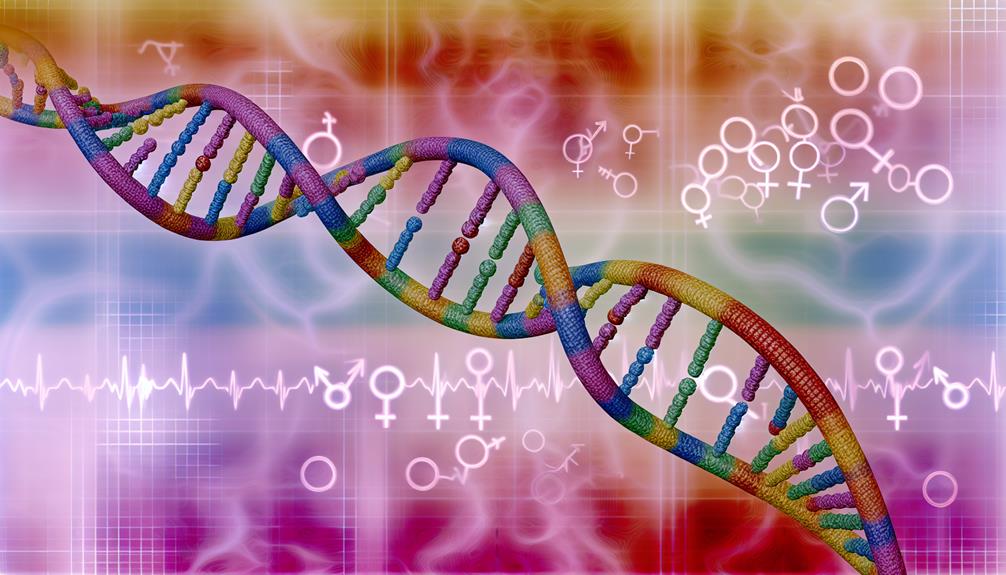The Hormonal Influence: Can Hormones Change Sexual Orientation?


Table of Contents
ToggleHave you ever wondered whether hormones can actually change who you’re attracted to? Imagine you’re influenced by a surge of testosterone even before you’re born. This could shape your sexual orientation, steering your attractions in unexpected directions. Hormones, like little chemical messengers, play a huge role in who we find attractive. But what happens if there’s an imbalance, or if you’re undergoing hormone therapy? These scenarios could potentially alter your sexual preferences. Curious about how this works and what it means for you or someone you know? Let’s explore this fascinating connection further.
Have you ever wondered how hormones can shape who we’re attracted to? It turns out that hormones, especially those we’re exposed to before birth, play a significant role in our sexual attraction.
Prenatal exposure to testosterone, for instance, has been linked to influencing sexual orientation. This means that the levels of testosterone you were exposed to as a fetus might’ve set the stage for who you find attractive later in life.
Studies suggest that hormonal imbalances during development can impact sexual attraction. For example, if there’s an unusual level of androgens, which are male hormones like testosterone, it might affect brain development in ways that shape your sexual orientation. This doesn’t mean hormones dictate everything, but they certainly have a strong influence.
Research indicates that androgen exposure in the womb may play a role in shaping sexual orientation. Hormones like testosterone and estrogen can influence how your brain develops, which in turn affects who you’re attracted to.
The interplay between these prenatal hormones and genetic factors could contribute to the diversity in sexual orientation we see in the world. So, while hormones aren’t the sole factor, they’re definitely a key piece of the puzzle.
Now that we’ve explored how hormones influence sexual attraction, let’s look at how testosterone specifically drives sexual desire. Testosterone isn’t just an essential hormone; it plays a vital role in sexual desire for both men and women. Higher testosterone levels can lead to increased libido and more frequent sexual thoughts.
In women, research shows that higher testosterone can boost sexual desire, especially during certain times in their menstrual cycle. For men, testosterone levels directly affect libido and sexual thoughts. If testosterone levels are low, men might experience a drop in sexual interest. Surprisingly, testosterone therapy has been found to improve sexual desire in those with low levels.
Here’s a quick snapshot of testosterone’s impact:
| Factor | Impact |
|---|---|
| Testosterone in women | Boosts sexual desire |
| Testosterone in men | Increases libido and sexual thoughts |
| Low testosterone in men | Reduced sexual interest |
| Testosterone therapy | Enhances sexual desire in both sexes |
| Menstrual cycle fluctuations | Affects women’s sexual desire |
Understanding testosterone’s role helps you see how intricate sexual desire really is. Whether male or female, hormone levels can significantly shape your sexual experiences and desires. So, if you’re curious about why you feel the way you do, keep an eye on those hormones!
Traumatic experiences can profoundly shape your sexual preferences, sometimes altering your orientation in unexpected ways. For example, if you experienced trauma during childhood, it might influence how you feel about intimacy and attraction later in life. This isn’t to say that trauma determines your sexual orientation, but it can play a significant role in shaping your preferences and behaviors.
Imagine someone who faced emotional or physical abuse growing up. They might find it challenging to form trusting relationships and may be drawn to partners who feel safe and understanding. This could mean a shift in sexual preferences over time, influenced by a need for emotional security.
Research shows a correlation between traumatic events and changes in sexual orientation. Understanding this link can help you better grasp why you might feel the way you do. It’s essential to recognize that psychological factors, including past traumas, can influence your sexual orientation development.
If you’ve faced trauma, seeking support can be an important step. Therapy and support groups can provide a safe space to explore your feelings and preferences. Remember, it’s okay to seek help and understand how your past might be influencing your present.
Understanding how hormones can shape your sexual orientation opens up a fascinating exploration into the effects of hormone therapy. When you undergo hormone therapy, whether for medical reasons or gender transformation, the changes in hormone levels in your body can influence your sexual attraction and preferences.
Here are three key effects of hormone therapy on sexual orientation:
Hormone therapies, like estrogen or testosterone, can result in shifts in who you’re attracted to. For instance, some people notice a change in their sexual preferences as their hormone levels adjust.
Hormone therapy can also impact your overall sexual drive. Testosterone, often used in gender transformation for trans men, can increase libido, while estrogen might have a different effect.
Changes in hormone levels can lead to shifts in sexual behaviors and identity. People often report feeling differently about their sexual orientation as they progress through hormone therapy.
It’s important to remember that these effects can vary widely from person to person. While some may experience significant changes, others might notice only subtle differences. Hormone therapy’s influence on sexual orientation remains an ongoing area of scientific research.
In relationships, feeling validated by your partner is essential for those exploring their sexual orientation. When your partner supports and accepts you, it can greatly enhance your self-esteem and confidence. Imagine you’re figuring out your sexual orientation; a partner who listens without judgment and reassures you that your feelings are valid can make a world of difference.
Validation isn’t just about agreeing with you; it’s about truly understanding and affirming your experiences. For instance, if you’re feeling uncertain about your attraction to different genders, your partner’s acceptance can diminish any internalized stigma you might have. This support helps you feel more at ease and secure in your identity.
Consider a scenario where you confess your evolving attraction to your partner. If they respond with empathy and encouragement, you’ll likely feel a sense of belonging and acceptance. On the other hand, if your partner dismisses your feelings, it could lead to self-doubt and emotional distress.
Supportive relationships foster an environment where you can openly explore your sexual orientation without fear. This acceptance is essential for anyone grappling with the intricacies of their sexual identity, ultimately leading to healthier, more fulfilling relationships.
Sexual orientation isn’t always set in stone and can shift over time due to various influences, including hormones.
While you might think your sexual orientation is fixed, several factors can lead to changes in your attractions and desires. Here are a few ways this fluidity can manifest:
Fluidity in sexual orientation underscores the complexity of human sexuality. It’s not just about biological factors but also how you interact with the world around you.
When exploring the fluidity of orientation, it’s important to also consider how we can support trans individuals in their journey. One key way to do this is by understanding the role of hormones.
Hormone replacement therapy (HRT) is often essential for trans people, helping align their physical characteristics with their gender identity. For example, administering testosterone to trans men or estrogen to trans women can greatly alleviate gender dysphoria and improve mental well-being.
Respecting and acknowledging a trans person’s gender identity is essential. It’s not just about using the correct pronouns but also about creating an inclusive environment where they feel safe and validated. Avoid making discriminatory remarks or dismissing their experiences as mere preferences. Each individual’s journey is unique, and your support can make a significant impact in their lives.
Medical guidelines support hormone therapy as a safe and effective means of gender alignment. By advocating for and respecting these treatments, you contribute to fostering a more inclusive society.
Imagine a puzzle with pieces from genetics, hormones, and environment. You don’t control your sexual orientation; it forms from these factors’ interplay.
Prenatal hormones like testosterone can shape your brain, influencing who you’re attracted to. Environmental experiences and self-acceptance also play roles.
You might wonder what factors determine a person’s sexual orientation. It’s a mix of biology, psychology, and personal experiences. Hormones like testosterone can influence attraction and libido.
Traumatic experiences and internalized homophobia might shape preferences. Plus, self-acceptance can evolve who you’re attracted to.
It’s not just about labels like gay or straight; it’s about finding happiness and self-love, regardless of orientation or gender identity.
Jumping into the time machine, you might wonder if sexual orientation can change during puberty. Yes, it can! Puberty is a rollercoaster of hormones and self-discovery.
You might start noticing attractions you didn’t have before. It’s like finding new music that resonates with you. Some people stay consistent, while others explore and evolve.
Two prenatal influences on sexual orientation are hormone levels and genetic factors.
When you’re a fetus, exposure to different levels of hormones like testosterone can impact your future sexual orientation. For example, higher prenatal testosterone levels are linked to same-sex attraction in females.
Additionally, genetic factors play a role; variations in specific genes might influence your sexual orientation as you develop.
Think of hormones like the directors of a play, guiding who we find attractive. They play a big role, but they’re not the only factor.
While hormone therapy and prenatal exposure to testosterone can influence sexual orientation, it’s clear that attraction is fluid and multifaceted.
Just as a rainbow has many colors, our sexual orientations are diverse and unique.
Supporting trans individuals and understanding these influences helps us appreciate the complexity of human attraction.
Originally posted 2024-05-15 19:40:30.
 News and AdvocacyNovember 14, 2025Rainbow Victories: 2025’s Most Pro-LGBTQ+ States Revealed
News and AdvocacyNovember 14, 2025Rainbow Victories: 2025’s Most Pro-LGBTQ+ States Revealed News and AdvocacyNovember 14, 2025Transgender Sanctuary States: Protecting Rights, Providing Hope
News and AdvocacyNovember 14, 2025Transgender Sanctuary States: Protecting Rights, Providing Hope Featured PostsNovember 13, 2025When Restroom Policing Backfires: The Hotel That Went Too Far
Featured PostsNovember 13, 2025When Restroom Policing Backfires: The Hotel That Went Too Far Featured PostsNovember 13, 2025Sex, Safety, and Seduction: A Trans Girl’s Guide to Hookups
Featured PostsNovember 13, 2025Sex, Safety, and Seduction: A Trans Girl’s Guide to Hookups